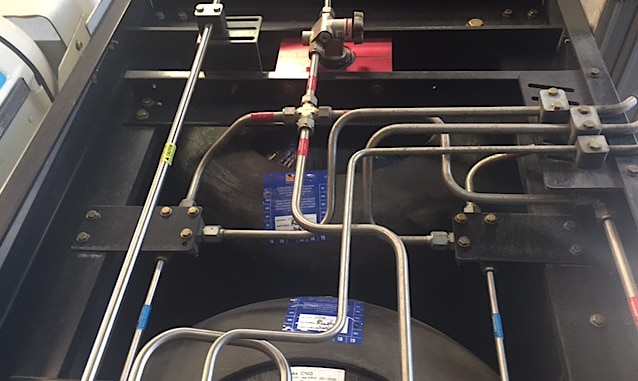
The Heavy-Duty Fuel System Inspection Interval Conundrum
We’re asked almost daily about the required interval for heavy-duty CNG fuel system inspections. Our answer is “it depends,” and then we explain.
These inspections are both required and essential because natural gas is stored on board CNG vehicles at extremely high pressures — at least 3,600 psi. While most CNG fuel systems are extremely safe due to their rigorous manufacturing, testing, and installation standards, there’s an increased risk for severe injury or loss of life if any components have been installed incorrectly, damaged, or otherwise compromised. So why isn’t there a clear-cut answer as to how often technicians should check them?
1992 saw the adoption of NGV2, a voluntary industry manufacturing standard for cylinders. It would ultimately be integrated through the American National Standards Institute (ANSI) process, and includes an in-use inspection interval stating, “Each container shall be visually inspected at least every 36 months, or at the time of any re-installation, for external damage and deterioration…”
In 1995, the National Highway Transportation Safety Administration (NHTSA), within the U.S. Department of Transportation, published a similar manufacturing standard that included a slightly different end-user inspection interval. Known as FMVSS 304, it states that CNG containers “should be visually inspected after a motor vehicle accident or fire and at least every 36 months or 36,000 miles, whichever comes first, for damage and deterioration.”
While both are manufacturing standards, the federal standard (FMVSS 304) that would seem most like “law” uses the phrase “should be visually inspected,” implying inspections are not mandatory.
Further complicating the problem, both NGV2 and FMVSS 304 “require” inspection of CNG cylinders, not the entire fuel system, while NGV industry best practices adopted in 2008 call for inspection of every component. Enter a lot of confusion, especially for heavy-duty CNG fleets.
Due to their high annual mileage, many heavy-duty CNG trucks require fuel system inspections every 11-13 weeks if they follow the FMVSS 304 standard. Affected fleet operators have found this requirement to be inconvenient and expensive, so at least two heavy-duty fuel system manufacturers now offer guidelines allowing a one-year/100,000-mile inspection interval instead.
Because FMVSS 304 is treated as a regulation, many corporate fleet risk managers are unwilling to adopt the manufacturers’ standards due to potential legal liability. If litigation does follow an incident involving a CNG fuel system — where the inspection interval or process is in question, and the vehicle owner did not adhere to the FMVSS 304 3-year/36,000-mile inspection interval — what is the likelihood that the courts will give a pass to the vehicle owner because they didn’t follow the published federal standard? It’s a hypothetical scenario, but one that fleet managers must carefully consider.
In 2019, NGV industry and American Trucking Association representatives petitioned NHTSA to adopt the 1-year/100,000-mile inspection interval. Unfortunately, two years later, NHTSA still has not acted on that petition, leaving heavy-duty fleet managers to choose between a federal inspection interval or manufacturers’ guidelines.
Until NHTSA acts on the petition, each fleet must choose their CNG fuel system inspection interval based on its analysis of risk versus reward. If you’re concerned about liability and how courts might interpret using a manufacturer’s guideline in the event of litigation, choose the 3-year/36,000-mile interval. If not, save time and money and conduct inspections on the 1-year/100,000-mile interval.
If you have questions about these standards, or other matters pertaining to the maintenance and diagnostics of your CNG fleet, give us a call at 800-510-6484.
